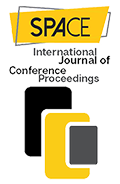Shattering the Glass Ceiling
Women’s Roles and Images in Iranian Architectural Magazines (1946-2001)
DOI:
https://doi.org/10.51596/sijocp.v4i1.6Keywords:
Architectural Magazines, Iran, Women, Representation, DiscourseAbstract
This paper examines the evolution of Iranian architectural magazines, focusing on discernible shifts in the involvement and portrayal of women during three distinct periods spanning from 1946 to 2001. From 1946 to 1969, female contributions to the magazines were markedly scarce initially, with depictions limited to non-progressive representations of women in traditional roles and endorsements directed towards the Queen. Along with the modern cultural initiatives of the Pahlavi state in the 1970s, the magazines transitioned from a prior disregard for female figures to occasionally recognising them as equally capable professionals. In contrast to this shift and the gradual growth in the number of educated and professional women before and after the 1979 revolution, the Islamic Republic embarked on a systematic effort to marginalise women and censor their images from public view. Challenging the post-revolutionary moments of limitation and censorship, few charismatic figures succeeded in redefining their roles and images in architectural magazines, especially after the revivals of 1991 and 1998 that were marked by the publication of two ground-breaking magazines. This study, supported by a comprehensive historical review, employs Theo van Leeuwen’s discourse analysis, revealing the intricate interplay of four discursive strategies in shaping women’s representation in Iranian architectural magazines across the three periods. The text underscores the impact of pre- and post-revolutionary societal and political changes. It highlights how the resilience of Iranian women led to an unprecedented redefinition of female professional roles in the 1990s.
References
Abadani va Maskan. (1966-1967). 1-4. The Ministry of Abadanai va Maskan. Tehran.
Abadi. (1991-1997). 1-23. The Research Center for Urban and Architectural Studies. Tehran.
Abrahamian, E. (2008). A History of Modern Iran. Cambridge University Press.
Amirrahimi, R., personal interview, April 2022.
Architecte. (1946-1948). 1-6. The Association of Iranian Diplom Architects. Tehran.
Axworthy, M. (2016). Revolutionary Iran: A History of the Islamic Republic. Oxford University Press.
Bank-e Sakhtemani. (1955-1958). 1(1-9). Bank-e Sakhtemani Association. Tehran.
Bank-e Sakhtemani. (1961-1962). 2(1-4). Bank-e Sakhtemani Association. Tehran.
Bidari-e Ma. (1944). 1(1). The Democratic Organisation of Iranian Women. Tehran.
Beski, S. (1998). Reviewing The Experience of Iran. Memar 1, 32-36.
Dehbashi, Ali. (2002, April-May). Interview with Engineer Eshragh. Bokhara, 23, 224-235.
Gharipour, M. (Ed.). (2019). Architectural Dynamics in Pre-Revolutionary Iran. Intellect Books Limited.
Ghasemi, F. (2011). Tarikh-e Matbouat-e Iran (The History of Iranian Press). Sanieh Publications.
Goffman, E. (1979). Gender Advertisements. Harper Torchbooks.
Grigor, T. (2005). Cultivat(ing) Modernities: The Society for National Heritage, Political Propaganda, and Public Architecture in Twentieth-Century Iran [Doctoral dissertation]. DSpace@MIT.
Hashemi, R., personal interview, February 2019.
Honar va Memari. (1969-1979). 1-48. The Association of Iranian Architects. Tehran.
Housing in Old Iran. (1957). Bank-e Sakhtemani, 1(2), 6-8.
Kaar, M. (2002). Mosharekat-e Siyasi-e Zanan (The Political Participation of Women). Tehran: Roshangaran.
Khosravi, H. (2019). CIAM Goes East: The Inception of Tehran’s Typical Housing Unit. Urban Planning, 4(3), 154-166. https://doi.org/10.17645/up.v4i3.2172
Lipstadt, H. (1982). Early Architectural Periodicals. In Middleton, R (Ed.), The Beaux-Arts and Nineteenth Century Architecture (pp. 50-57). Thames and Hudson.
Mehran, G. (2009). “Doing and Undoing Gender”: Female Higher Education in The Islamic Republic of Iran. International Review of Education 55(5/6), 541-559. http://www.jstor.org/stable/40608077
Menashri, D. (1992). Education and The Making of Modern Iran. Cornell University Press.
Memar. (1998-2001). 1-14. Memarnashr Publications. Tehran.
Memari-e Novin. (1961-1962). 1(1-5). Vartan Avanesian. Tehran.
Memari-e Novin. (1964-1965). 2(1-2). Vartan Avanesian. Tehran.
Mirzaei, Z. (2016). The Idea of Architecture in Iran [Unpublished Master’s Thesis]. Shahid Beheshti University.
Mitch, D. (2019). Globalization and the Rise of Women’s Literacy and Primary Education in Iran, from 1880 to the Present Day. In Mitch. D & G. Cappelli (Eds.), Globalization and the Rise of Mass Education (pp.311-334). Springer Nature.
Parnell, S. (2011). Architectural Design, 1954-1972. [Doctoral dissertation]. University of Sheffield, School of Architecture. Retrived from https://etheses.whiterose.ac.uk/14585/1/573129.pdf (last access: 28 March 2024)
Pishvaei, Hamidreza., et al. (2020). Analysing Key Categories in the Literature of Contemporary Iranian Architecture; 1946-2016. Soffeh 30(89), 17-44. Retrived from https://www.magiran.com/paper/2122975/analyzing-key-categories-in-the-literature-of-contemporary-iranian-architecture-1946-2016?lang=en (last access: 27 March 2024)
Qayyoomi, M. (2009). On the Written Sources of the History of Iranian Architecture and the Searching Principles. Golestan-e Honar 1, 5-20.
Rasooli, N. (2018). The Women Architects of Iran: Their Practice and Influence (1940-1976). In H. Seražin, C. Franchini and E. Garda (Eds.), Women’s Creativity since the Modern Movement (1918–2018) (pp.365-372). Routledge.
Sanasarian, E. (1982). The Women’s Rights Movement in Iran: Mutiny, Appeasement, and Repression from 1990 to Khomeini. CBS Education and Professional Publishing.
Shahidi, H. (2002). Women and Journalism in Iran. In Ansari, S, & V. Martin (Eds.), Women, Religion and Culture in Iran (pp. 70–87). Routledge.
Shahidian, H. (1994). The Iranian Left and The “Woman Question” in The Revolution of 1978-79. International Journal of Middle East Studies, 26(2), 223-247. http://www.jstor.org/stable/164734
Smitheram, Jan. (2012). Regulation and Transformation: A Content Analysis of the Representation of Women in Architecture New Zealand, 1998–2008. Architectural Theory Review 17 (2-3), 299-316. https://doi.org/10.1080/13264826.2012.738691
The Crisis of Identity in Architecture: Report of the Proceedings of the International Congress of Women Architects, Ramsar, Iran, 1976. (1976). (pp. 3-4). Tehran: Hamdami Foundation.
The Story of Architectural Education in Iran. (1991). Abadi, 3(2), 2-7.
Vanlaethem, France., Jannière, H., & Sornin, Alexis. (2008). Revues d’architecture dans les années 1960 et 1970 : Fragments d’histoire événementielle, intellectuelle, matérielle/Architectural Periodicals in the 1960s and 1970s: Towards a Factual, Intellectual and Material History. IRHA.
Van Leeuwen, Theo. (2007). Legitimation in discourse and communication. Discourse & Communication, 1(1), 91–112.
Van Leeuwen, Theo. (2008). Discourse and Practice: New Tools for Critical Discourse Analysis. Oxford University Press.
Zarei, S. (2015). The Seen and Unseen: A study on Andre Godard’s viewpoint in recognition of Iranian artwork. Master’s thesis, Shahid Beheshti University.
Published
How to Cite
Issue
Section
Categories
License
Copyright (c) 2024 Sina Zarei

This work is licensed under a Creative Commons Attribution 4.0 International License.













